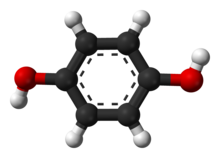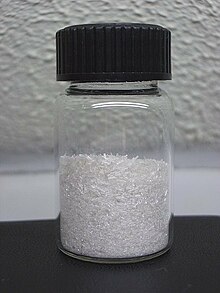하이드로퀴논
보이기

| |

| |

| |
| 이름 | |
|---|---|
| 우선명 (PIN)
Benzene-1,4-diol[1] | |
| 별칭 | |
| 식별자 | |
3D 모델 (JSmol)
|
|
| 605970 | |
| ChEBI | |
| ChEMBL | |
| ChemSpider | |
| DrugBank | |
| ECHA InfoCard | 100.004.199 |
| EC 번호 |
|
| 2742 | |
| KEGG | |
PubChem CID
|
|
| RTECS 번호 |
|
| UNII | |
| UN 번호 | 3077, 2662 |
CompTox Dashboard (EPA)
|
|
| |
| |
| 성질 | |
| C6H6O2 | |
| 몰 질량 | 110.112 g·mol−1 |
| 겉보기 | White solid |
| 밀도 | 1.3 g cm−3, solid |
| 녹는점 | 172 °C (342 °F; 445 K) |
| 끓는점 | 287 °C (549 °F; 560 K) |
| 5.9 g/100 mL (15 °C) | |
| 증기 압력 | 10−5 mmHg (20 °C)[2] |
| 산성도 (pKa) | 9.9[3] |
자화율 (χ)
|
−64.63×10−6 cm3/mol |
| 구조 | |
| 1.4±0.1 D[4] | |
| 약리학 | |
| D11AX11 (WHO) | |
| 위험 | |
| GHS 그림문자 |    
|
| 신호어 | 위험 |
| H302, H317, H318, H341, H351, H400 | |
| P201, P202, P261, P264, P270, P272, P273, P280, P281, P301+312, P302+352, P305+351+338, P308+313, P310, P321, P330, P333+313, P363, P391, P405, P501 | |
| NFPA 704 (파이어 다이아몬드) | |
| 인화점 | 165 °C (329 °F; 438 K) |
| 반수 치사량 또는 반수 치사농도 (LD, LC): | |
LD50 (median dose)
|
490 mg/kg (mammal, oral) 245 mg/kg (mouse, oral) 200 mg/kg (rabbit, oral) 320 mg/kg (rat, oral) 550 mg/kg (guinea pig, oral) 200 mg/kg (dog, oral) 70 mg/kg (cat, oral)[5] |
| NIOSH (미국 건강 노출 한계): | |
PEL (허용)
|
TWA 2 mg/m3[2] |
REL (권장)
|
C 2 mg/m3 [15-minute][2] |
IDLH (직접적 위험)
|
50 mg/m3[2] |
| 관련 화합물 | |
관련 benzenediols
|
Pyrocatechol Resorcinol |
관련 화합물
|
1,4-benzoquinone |
달리 명시된 경우를 제외하면, 표준상태(25 °C [77 °F], 100 kPa)에서 물질의 정보가 제공됨.
| |
하이드로퀴논(Hydroquinone)은 페놀류의 일종이자 벤젠 파생물인 방향족성 유기 화합물이다. 화학식은 C6H4(OH)2이다. 2개의 하이드록시기가 측면 위치의 벤젠에 결합되어 있다. 흰색의 고체이다. 이 용어는 1843년 프리드리히 뵐러가 만들었다.[7]
같이 보기
[편집]각주
[편집]- ↑ 가 나 〈Front Matter〉. 《Nomenclature of Organic Chemistry : IUPAC Recommendations and Preferred Names 2013 (Blue Book)》. Cambridge: The Royal Society of Chemistry. 2014. 691쪽. doi:10.1039/9781849733069-FP001. ISBN 978-0-85404-182-4.
- ↑ 가 나 다 라 NIOSH Pocket Guide to Chemical Hazards. “#0338”. 미국 국립 직업안전위생연구소 (NIOSH).
- ↑ “Hydroquinone” (PDF). 《OECD SIDS》. UNEP Publications. 2016년 10월 20일에 원본 문서 (PDF)에서 보존된 문서. 2022년 4월 23일에 확인함.
- ↑ Lander, John J.; Svirbely, John J. Lander, W. J. (1945). “The Dipole Moments of Catechol, Resorcinol and Hydroquinone”. 《Journal of the American Chemical Society》 67 (2): 322–324. doi:10.1021/ja01218a051.
- ↑ “Hydroquinone”. 《Immediately Dangerous to Life and Health Concentrations (IDLH)》. National Institute for Occupational Safety and Health (NIOSH).
- ↑ “Archived copy” (PDF). 2014년 2월 2일에 원본 문서 (PDF)에서 보존된 문서. 2014년 1월 25일에 확인함.
- ↑ F. Wöhler (1844) "Untersuchungen über das Chinon" (Investigations of quinone), Annalen der Chemie und Pharmacie, 51 : 145-163. From page 146: "Das so erhaltene Destillat … enthält … einen neuen, krystallisierenden Körper, den ich unter dem Namen farbloses Hydrochinon weiter unten näher beschreiben werde." (The distillate so obtained … contains … a new, crystallizable substance, that I will describe, under the name of colorless hydroquinone, further below in more detail.) [Note: Wöhler's empirical formula for hydroquinone (p. 152) is incorrect because (1) he attributed 25 (instead of 24) carbon atoms to the molecule, and (2) as many chemists at the time did, he used the wrong atomic masses for carbon (6 instead of 12) and oxygen (8 instead of 16). With these corrections, his empirical formula becomes: C12H12O4. Dividing the subscripts by 2, the result is: C6H6O2, which is correct.]

